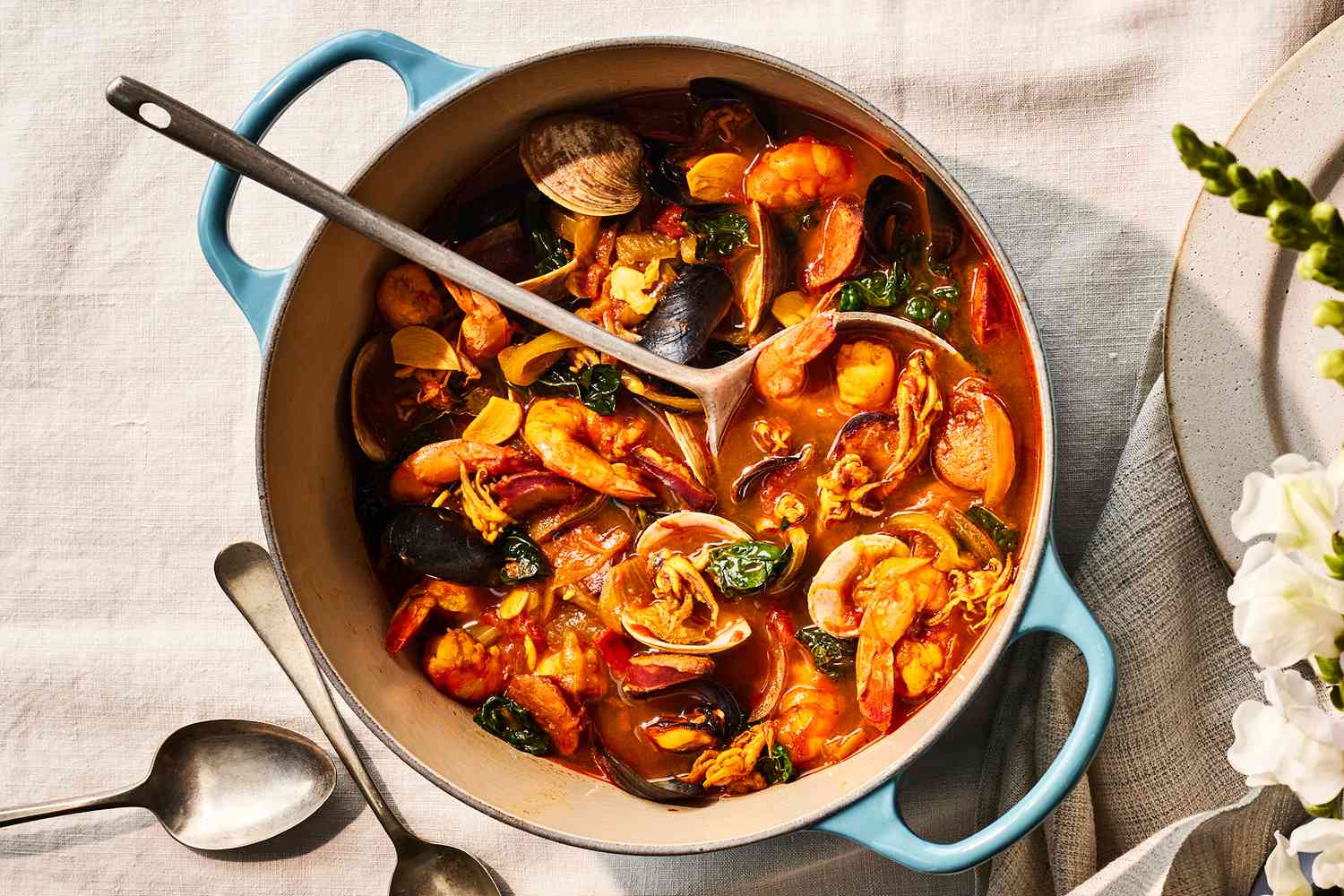Portuguese Soup: Traditional Recipes and Regional Favorites
Portuguese soup, or “sopa,” dates back centuries, originating from rural communities. Farmers and fishermen would craft hearty soups to maximize the use of available ingredients. Traditional recipes have been passed down, preserving culinary heritage. Some of these soups have evolved over time, adapting to modern preferences while maintaining their historical roots.
Key Ingredients That Define Portuguese Soups
Portuguese soups often feature ingredients like potatoes, kale, and chorizo. Potatoes thicken and enrich the soup. Kale, essential in caldo verde, adds a fresh, slightly bitter flavor. Chorizo provides a smoky, meaty depth. Fresh seafood, including fish and shellfish, is crucial for sopa de peixe, delivering robust maritime flavors. Beans and legumes, like lentils and chickpeas, add protein and texture. Garlic, onions, and olive oil form the base for many recipes, providing aromatic and savory notes.
Popular Types of Portuguese Soup
Caldo Verde – Portugal’s Green Broth
Caldo Verde is a traditional Portuguese green broth. It’s popular for its simplicity and rich flavor. The main ingredients include potatoes, collard greens (or kale), chorizo, and onions. This soup often serves as a starter at family gatherings and festive occasions. Flavor variations depend on the region, but the essence remains consistent—hearty and flavorful.
Sopa da Pedra – The Stone Soup
Sopa da Pedra, or Stone Soup, has deep roots in Portuguese folklore. The soup’s name originates from a legend where a monk convinces villagers to contribute ingredients by starting with just a stone. Today’s version includes beans, potatoes, chorizo, pork, and vegetables like cabbage and carrots. It’s a thick, satisfying soup celebrated for its communal spirit and flavorful depth.
Canja de Galinha – Comfort in Chicken Soup
Canja de Galinha is a beloved chicken soup in Portuguese cuisine. Ingredients typically include rice, chicken, onions, carrots, and sometimes mint. Known for its soothing properties, Canja de Galinha is often served to those feeling under the weather. The broth is light yet nourishing, making it a perfect comfort food year-round.
Health Benefits of Eating Portuguese Soup
Nutritional Content Overview
Portuguese soups like Caldo Verde, Sopa da Pedra, and Canja de Galinha are rich in nutrients essential for a balanced diet. Caldo Verde provides a good source of Vitamin C, Vitamin K, and dietary fiber from collard greens. It’s also rich in potassium and magnesium due to the potatoes. Sopa da Pedra offers an abundance of protein from pork and beans, along with essential vitamins like B-complex vitamins from vegetables. Canja de Galinha, a chicken soup, contains lean proteins and is fortified with vitamins like Vitamin A and B6 from vegetables such as carrots and onions.
How These Soups Benefit Your Well-being
Portuguese soups offer numerous health benefits. Caldo Verde may aid in digestion and improve cardiovascular health thanks to its fiber content and phytonutrients from collard greens. Sopa da Pedra can enhance muscle repair and energy levels due to its high protein and complex carbohydrate content, supporting bodily functions and maintaining a strong immune system. Canja de Galinha, known for its soothing properties, can help in cold recovery and provide comfort through its warm and nutrient-rich broth, which can also aid in hydration and digestive health.
Each soup contributes to overall well-being, from enhancing nutrient intake to supporting immunity and digestion.
Regional Variations of Portuguese Soup
Northern Portugal’s Hearty Flavors
Northern Portugal offers hearty soups that reflect the region’s cooler climate. A popular example is “Caldo Verde,” made with collard greens, potatoes, and chorizo. This soup is nutrient-dense and provides energy, ideal for colder weather. Another staple is “Sopa de Legumes,” packed with various vegetables like carrots, cabbage, and turnips. It’s nutritious and versatile, allowing for seasonal variations.
Coastal Delights: Fish and Seafood Soups
Coastal regions emphasize fish and seafood in their soups. “Sopa de Peixe” features fish like cod or monkfish with tomatoes, onions, and garlic. It offers a flavorful, protein-rich meal. “Açorda de Mariscos,” a bread-based soup, includes shrimp, clams, and sometimes crab. It combines fresh seafood with garlic, cilantro, and olive oil, creating a unique taste profile.
Cooking Portuguese Soup at Home
Essential Tips for Authentic Flavor
Use Fresh Ingredients: Select fresh, high-quality ingredients, like vegetables and herbs, for maximum flavor. Fresh produce enhances the classic taste of Portuguese soups.
Incorporate Traditional Spices: Include spices such as paprika, garlic, and bay leaves. They are fundamental in traditional Portuguese soups, contributing to the rich, aromatic profile.
Simmer, Don’t Boil: Allow your soup to simmer gently to blend the flavors effectively. Boiling can make the vegetables mushy and disrupt the delicate balance.
Choose the Right Broth: Use homemade chicken or beef broth for deeper, authentic flavors. Store-bought broths may lack the richness that traditional recipes require.
Focus on Texture: Achieve the correct consistency by blending part of the soup if necessary. Many Portuguese soups, like Caldo Verde, rely on a smooth yet hearty texture.
Recommended Recipes for Beginners
Caldo Verde: This popular kale soup is easy to start with. Ingredients include kale, potatoes, onions, garlic, and chouriço sausage. Simmer potatoes and onions until tender, blend, then add kale and sausage for the final 15 minutes.
Sopa de Legumes: Ideal for vegetables lovers, this soup uses carrots, potatoes, leeks, and more. Cook chopped vegetables in broth until tender, blend for a smooth texture, and add a touch of olive oil.
Canja de Galinha: A simple chicken soup with rice, perfect for beginners. Simmer chicken pieces with onions, garlic, carrots, and rice until the rice is cooked through and the broth is flavorful.
Sopa de Peixe: For seafood fans, this fish soup offers a taste of the coast. Use white fish like cod, along with tomatoes, onions, and garlic. Simmer fish with other ingredients and finish with fresh herbs.
Each recipe introduces essential techniques and flavors, providing a solid foundation for mastering Portuguese soups.
Conclusion
Exploring Portuguese soups opens up a world of rich flavors and culinary traditions. By using fresh ingredients and traditional spices, you can bring authentic Portuguese tastes into your kitchen. Whether you’re a beginner or an experienced cook, the recommended recipes like Caldo Verde and Sopa de Legumes provide a perfect starting point. Dive into these comforting dishes and enjoy the unique textures and flavors that Portuguese soups offer. Embrace the techniques and ingredients that make these soups special, and you’ll soon master the art of Portuguese sopa.






